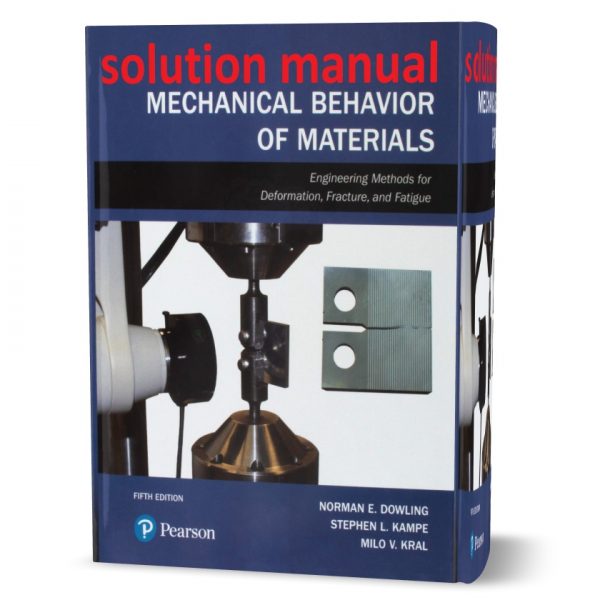Mechanical Behavior of Materials Engineering Methods for Deformation Fracture and Fatigue 5th edition Norman Dowling solutions manual
Original price was: $40.00.$32.00Current price is: $32.00.
Published: Pearson 2018
Edition: 5th
Pages: 617
Type: pdf
Size: 65MB
Content: chapter 1 to 16 answers ( not all question have been answered ). click below link to see answered question
answered question: click here
Sample: solution sample file
Download After Payment
- Description
- Reviews (0)
Description
Description
Download free Mechanical Behavior of Materials Engineering Methods for Deformation Fracture and Fatigue 5th edition Norman Dowling solutions manual pdf Designing machines. vehicles. and structures that are safe, reliable, and economical requires both efficient use of materials and assurance that structural failure will not occur. It is therefore appropriate for undergraduate engineering majors to study the mechanical behavior of materials, specifically such topics as deformation, fracture, and fatigue This book may be used as a text for courses on mechanical behavior of materials at the junior or senior undergraduate level, and it may also be employed at the first-year graduate level by emphasizing the later chapters. for more solution manual click here.
Mechanical Behavior of Materials Engineering Methods for Deformation Fracture and Fatigue 5th edition Norman Dowling solutions manual
The Download free Mechanical Behavior of Materials Engineering Methods for Deformation Fracture and Fatigue 5th edition Norman Dowling solutions manual pdf coverage includes traditional topics in the area. such as materials testing, yielding and plasticity, stress-based fatigue analysis, and creep. The relatively new methods of fracture mechanics and strain-based fatigue analysis are also considered and are, in fact, treated in some detail. For a practicing engineer with a bachelor’s degree. this book provides an understandable reference source on the topics covered. Emphasis is placed on analytical and predictive methods that are useful to the engineering designer in avoiding structural failure. These methods are developed from an engineering mechanics viewpoint, and the resistance of materials to failure is quantified by properties such as yield strength. fracture toughness, and stress—life curves for fatigue or creep.
The Download free Mechanical Behavior of Materials Engineering Methods for Deformation Fracture and Fatigue 5th edition Norman Dowling solutions manual pdf intelligent use of materials property data requires some understanding of how the data are obtained, so their limitations and significance are clear. Thus. the materials tests used in various areas are generally discussed prior to considering the analytical and predictive methods.
In many of the areas covered, the existing technology is more highly developed for metals than for nonmetals. Nevertheless, data and examples for nonmetals, such as polymers and ceramics, are included where appropriate. Highly anisotropic materials, such as continuous fiber composites are also considered, but only to a limited extent. Detailed treatment of these complex materials is not attempted here. The remainder of the Preface first highlights the changes made for this new edition. Then comments follow that are intended to aid users of this book, including students, instructors. and practicing engineers.
WHAT IS NEW IN THIS EDITION?
Relative to the fourth edition, this fifth edition features improvements and updates throughout. Areas that received particular attention in the revisions include the following: The end-of-chapter problems and questions are extensively revised, with more than 32% being new or significantly changed. • There are 30 new illustrations and ten additional ones with major improvements. • A new chapter on Environmentally Assisted Cracking replaces the previous short section on this topic.
It Download free Mechanical Behavior of Materials Engineering Methods for Deformation Fracture and Fatigue 5th edition Norman Dowling solutions manual pdf contains 11 of the aforementioned new illustrations and five new tables, • The chapter on basic materials tests has been split into two chapters, Chapter 3 covering tension tests, and Chapter 4 covering the other basic tests. • The previous chapter on A Survey of Engineering Materials has been moved to near the end of the book to become Appendix C. but with the materials selection topic moved to Chapter 3. • The materials science and physical mechanisms treatment has been enhanced in Chapters 2 and 3, and in Appendix C. In Chapter 2, this includes expanded discussion of defects in materials. And in Chapter 3.
there is Download free Mechanical Behavior of Materials Engineering Methods for Deformation Fracture and Fatigue 5th edition Norman Dowling solutions manual pdf an entire new section covering this area. • The topic of true stresses and strains for tension tests in Chapter 3 has been updated to include a new method for making the correction for triaxial stress due to necking. • Eight in-text Examples are new or have been significantly improved. • The end-of-chapter reference lists are reworked and updated to include recent publications. including databases of materials properties.
PREREQUISITES
Download free Mechanical Behavior of Materials Engineering Methods for Deformation Fracture and Fatigue 5th edition Norman Dowling solutions manual pdf Elementary mechanics of materials. also called strength of materials or mechanics of deformable bodies provides an introduction to the subject of analyzing stresses and strains in engineering components, such as beams and shafts, for linear-elastic behavior. Completion of a standard (typically sophomore) course of this type is an essential prerequisite to the treatment provided here.
Some useful review and reference material in this area is given in Appendix A. along with a treatment of !Lily plastic yielding analysis. Many engineering curricula include an introductory (again, typically sophomore) course in materials science, including such subjects as crystalline and noncrystalline structure, dislocations and other imperfections, deformation mechanisms, processing of materials, and naming systems for materials. Prior exposure to this area of study is also recommended.




Reviews
There are no reviews yet.